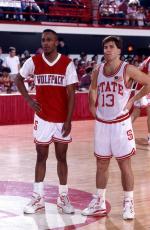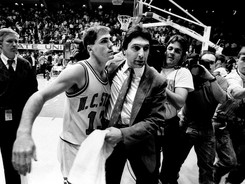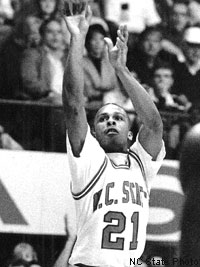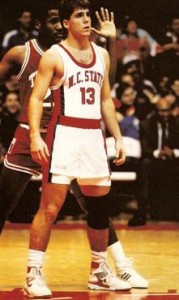Past Imperfect: The Ballad of Fire & Ice
Posted by JWeill on January 26th, 2012Past Imperfect is a series focusing on the history of the game. Every two weeks, RTC contributor Joshua Lars Weill (@AgonicaBoss|Email) highlights some piece of historical arcana that may (or may not) be relevant to today’s college basketball landscape. This week: the dynamic duo of Chris Corchiani and Rodney Monroe.
Clearly, NC State coach Jimmy Valvano loved nicknames. He reveled in being “Jimmy V”. He started referring to his erratic star big man Charles Shackleford as “Shack” long before Shaq was Shaq. So it’s not surprising two star freshmen in 1987 would eventually get their own aliases.
But taking a glance at the pasty white point guard from Florida and his reed-thin fellow freshman from Maryland, would anyone have ever come up with the monikers “Fire” and “Ice”? Perhaps not at first. But it didn’t take long for Chris “Fire” Corchiani and Rodney “Ice” Monroe to earn their nicknames, and much more.
Corchiani meshed well with the fiery (and proudly, even comically, Italian-American) Valvano right off the bat. A Florida prep legend that was named Florida’s Mr. Basketball in 1986 and again in 1987, Corchiani was a passionate and talkative pass-first point guard, a coach’s son who loved winning basketball games even more intensely than he hated to lose them. By the time he left for Raleigh, Corchiani had set Florida prep marks for both career points and career assists.
Monroe had also had a record-breaking high school career, establishing a Maryland state high school record for scoring with over 3,000 points. Coming out of Baltimore’s tough Catholic league, Monroe had his pick of programs, but ultimately chose the Wolfpack over his home state school. This was due in part to the departure of popular Terrapins coach Lefty Dreisell, but had more to do with the chance to play alongside Corchiani, whom Monroe had first met at a high school camp a year before. As any good scorer knows, playing with someone who can get you the ball means more chances to shoot. Both had been point guards in high school, but Valvano knew what he wanted.
“[Corchiani] was a point [guard] who thought pass first and shoot second. That’s why it was a joy to play with him because I thought shoot first. We really had a great combination,” Monroe said later.
With future pros Chucky Brown, Vinny Del Negro, and Shackleford already in the fold, Monroe’s immediate role would be as instant offense off the bench, and that’s just what he was. Corchiani, meanwhile, moved seamlessly into the starting lineup and racked up 235 assists as a freshman. Valvano’s motion offense meant lots of looks for Del Negro and Brown, and lots of cleanup for Shackleford. Monroe came in launching as the team’s sixth man. After a 24-win campaign, however, NC State was shocked by Murray State in the first round of the NCAA tournament, the beginning of a pattern of NCAA struggles that would haunt this vaunted duo.
It would be as sophomores that the Fire and Ice duo would more fully gain national attention. With Del Negro gone to the NBA, Monroe got his shot, and shoot he would. Playing the game with a quiet intensity, and never afraid to hoist up a deep one, Monroe was the icy compliment to Corchiani’s fiery temperament. Riding Monroe’s three-point bombs, Brown’s interior brawn and Corchiani’s total floor game, NC State won 22 games in 1988-89 and earned a 5-seed in the NCAA tournament, where it dispatched South Carolina and Iowa easily.
The Wolfpack’s run would be stopped, however, on a questionable traveling call on Corchiani that negated a potential game-tying bucket with under two minutes to do. With Alonzo Mourning doing damage inside (12 points, 12 rebounds, and 7 blocks), Georgetown would go on to beat NC State, 69-61. Still, the season had been a good one, with the Wolfpack finishing the regular season as ACC champions and reaching the Sweet 16. Hopes were high for the next year, with Fire and Ice returning as upperclassmen and talented young big man Tom Gugliotta joining the starting lineup.
Instead of a triumph, the 1989-90 season would become a trial for Corchiani, Monroe, and the Wolfpack team. Playing with a pall over its head, NC State started strong before an NCAA investigation into Valvano and the program resulted in the program being banned from competing in the 1990 NCAA tournament. The stress of the constant threat of probation and punishment eventually wore the players down mentally and turned what should have been a conference title-contending team into a middle-of-the-ACC also-ran. Sitting at 17-6 with a win at North Carolina, the Pack collapsed, dropping six of its last seven, including a season-ending defeat to Georgia Tech in the ACC Tournament. The NCAA Tournament ban meant the Wolfpack had no NCAA Tournament spot to play for or to look ahead to.
Then, on April 7, 1990, the season completed, NC State decided to take action and Jim Valvano was fired. Corchiani, still enamored of the coach who had recruited him, seriously contemplated transferring. Monroe thought about going NBA hardship and forgoing his final season of eligibility.
But Valvano’s replacement, Les Robinson, a former NC State player and the successful coach at The Citadel and East Tennessee State, sat with both players, and Fire and Ice both agreed to give it another chance. It helped that Robinson had a relationship with both already in place. The summer before, Robinson had been an assistant for the U.S. team that competed in the world championships and Corchiani and Monroe had been a part of that roster. Also in his favor was that Robinson’s offensive style suited both well – lots of three-pointers and a full-court running game.
“We’re a little more up-tempo,” Robinson said. “We believe in using the three-point shot liberally. Chris and Rodney seem to like it.”
They liked it plenty, and they flourished under the new management. Monroe averaged 27 points per game, once hanging 48 on Georgia Tech, and would be named the conference’s Player of the Year. Corchiani more than doubled his scoring average and eventually set a conference and then the NCAA overall record for career assists.
But despite their personal successes, the Wolfpack didn’t meet expectations, managing only a 20-11 record. There was too little consistency, with NC State never winning more than three games in a row during the season. The final game of Fire and Ice’s glorious careers was a disappointing 73-64 second-round loss to Oklahoma State, whose coach, Eddie Sutton, had himself left a program (Kentucky) under duress. In that game, Sutton’s Cowboys played Corchiani end-to-end and Monroe straight up, eschewing the gimmick defenses other teams had often thrown at NC State. The result was an off shooting night for Ice, who scored 19 points but did so on 4-of-16 from the field. Fire had his own troubles, committing seven turnovers in the game.
In some ways, it was as if all that attitude, bravado and vigor that Valvano had brought to the program had gone with him, sucked into his departing vortex. The talent was there, but not the same hunger nor the team depth. Still, it is hard to find much fault in the final tallies for Fire and for Ice. Rodney ‘Ice’ Monroe finished his NC State career with an astounding 2,551 points, breaking the school record set by basketball Hall of Famer David Thompson. ‘Fire’ Corchiani became the first player to reach 1,000 career assists, establishing the NCAA mark with 1,038. Bobby Hurley would eclipse Corchiani’s record two seasons later, but Corchiani is still one of only three players ever to surpass 1,000 assists.
On NBA Draft night, Monroe was selected in the second round with the 30th pick, his running mate Corchiani six spots later. It seems remarkable that neither the ACC MVP nor the NCAA all-time leader in assists were considered strong NBA prospects, but maybe that’s actually fitting. Each had made the most of his abilities to overcome his deficiencies. Corchiani made up for a visible lack of athleticism with superior court vision and moxie. Monroe got by a lack of strength and height with deep range and a binge scoring ability that could change a game completely.
And in truth, neither player was much of an NBA player. Monroe’s career lasted a single season, and Corchiani’s just four. But both were capable players and eventually they found places to continue torching opponents. Corchiani took his passion and his passes to Turkey, Italy, Spain, and Germany. Monroe found buckets in Australia, Greece, Italy, and Israel.
Eventually, once basketball was done, the two came back to the Raleigh area and settled in, returning to where they had both found so much glory together, revisiting the place where a pugnacious point guard and a skinny scorer became, forever, Fire and Ice.















































First time on the site. Nice article Joshua. I’m a wolfpack fan and I love a classic point/shooter combo backcourt.We may have a similar duo with incoming recruits Tyler Lewis and Rodney Purvis. A fan can dream right?
Great article and series …I looooooved Ice!!